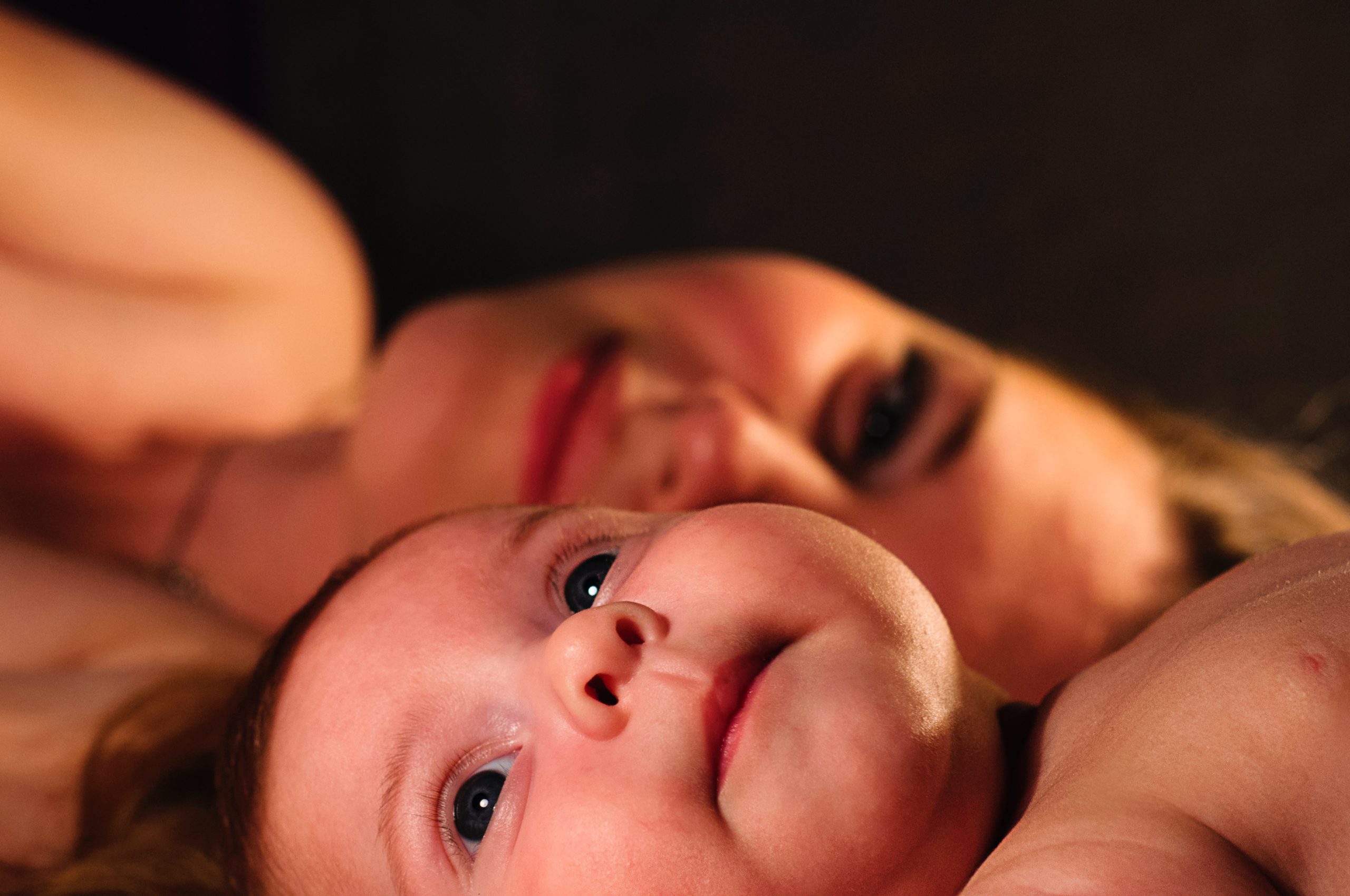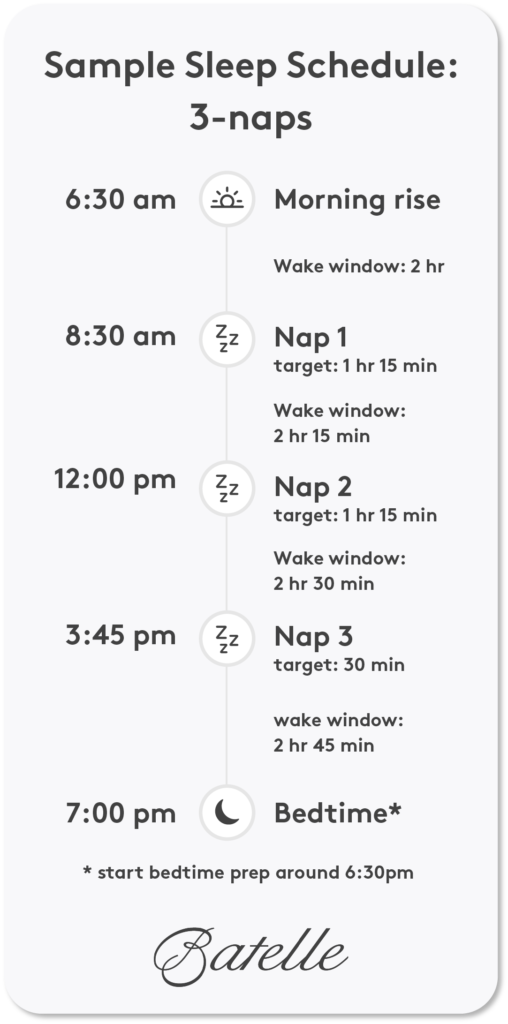
GET STARTED WITH A FREE CUSTOM SCHEDULE AND PLAN OVERVIEW ON OUR MOBILE APP →
TRY BATELLE FOR FREE →

Happy half-birthday to your little one! Though I’m sure the hours and days have sometimes felt long, somehow 6 whole months have flown by! By 6 months, most of the effects of the 4-month sleep regression have likely passed (just in time for the 6-month sleep regression), and you’re probably enjoying a little more consistency with naps. Many 6-month-olds have transitioned from a 4-nap schedule to a 3-nap schedule. Let’s take a look at what to expect this month with your 6-month-old-baby’s sleep schedule.
Always use your baby’s adjusted age when considering sleep schedules. Also, keep in mind that there is a wide range of normal when it comes to sleep needs. The recommendations in this article represent average sleep totals for this age, but your baby’s sleep needs may be higher or lower than the averages, and that’s ok. The most important thing is to take into account your little one’s overall demeanor. If your baby seems well-rested, they are likely getting enough sleep—regardless of the sleep durations discussed below.
The National Sleep Foundation recommends 6-month-olds get 12-16 hours of sleep in a 24-hour period. That sleep total includes both naps and nights. Aim for 10-12 hours of nighttime sleep, and 2.5-3.5 hours of daytime sleep split between 3 naps.

Note: Nap duration for any particular nap may vary. Typically, the first naps of the day are longer, and the last nap of the day is a cat nap (30-45 minutes). The most important thing is to ensure total daytime sleep is 2.5-3.5 hours. Remember, that’s just an average – if your little one is doing well with more or less daytime sleep than that, that’s great! Don’t stress the numbers too much.
Most 6-month-old babies take 3 naps each day. Average wake windows for a 6-month-old baby are 2-3 hours. If your little one is still taking more than 3 naps, it may be time to increase their awake time between naps to increase sleep pressure and encourage longer naps.
Keep in mind that short naps are still very normal at this age. It’s also very normal if your little one only takes longer naps when in contact with you. Adjusting wake windows and giving your baby some practice time awake in their sleep space so it becomes familiar can sometimes help.
Sometime between now and 8 months of age, your little one’s wake windows will increase as they can comfortably handle more time awake. This shift leads to the third nap of the day getting more challenging and getting pushed later in the day, which then makes bedtime creep steadily later. This can be a sign that your little one is transitioning from 3 naps to 2 naps.
The goal is that your little one will be in their sleep space overnight for 10-12 hours. Most 6-month-olds begin to sleep through the night between 6-9 months. However, “sleeping through the night” can vary in definition. For some, it might mean a 7-hour stretch without waking for a feed or other needs, while for others, it could mean longer durations with brief wake-ups.
If your little one was not born prematurely and is on track with their weight gain, 1-2 feeds during the night are normal—especially for breastfed babies. If your little one is feeding more than 3 times during the night, keep an eye on their daytime feeds. The goal is that your little one gets the majority of their feeds in during the day so they’re able to sleep for longer stretches at night.
One thing to keep in mind with night feeding at this age is to consider if it’s working well. Generally, if your little one is waking due to hunger, they will settle back to sleep once that need has been met. However, if a feed results in sleep disruption because your little one is too stimulated by the feed, or perhaps they latch on and don’t take a full feed, it might be time to introduce some more variety in your soothing routine so that your little one can settle to sleep in more ways than just feeding.
For example, when your baby wakes, first observe and listen to them to see if they might just be fussing between sleep cycles. From there, respond verbally to your little one, maybe saying something like “I hear you, baby. It’s sleep time.” Then, go to your baby and place a soothing hand on their body or head while humming a lullaby or talking softly to them. If that doesn’t result in your little one settling, pick them up and maybe rock or walk around the room a little bit. From there, if needed, offer a feed. In this way, you’re climbing up a metaphorical ladder of soothing techniques, pausing on each rung to assess if more support is needed. You may end up feeding your little one, but it’s not the first thing you go to as a solution to the wake-up.
Note: Always consult your pediatrician before making changes to your baby’s feeding schedule
If your little one can move around to find comfortable sleeping positions, can intentionally bring their hands to their mouth, and their sleep schedule has started to become a little more predictable, it might be a good time to consider sleep training. Movement and the ability to suck on fingers and hands are both early self-soothing skills. Additionally, if you’ve not already created a consistent bedtime routine, now is a great time to start. Consistent routines help signal sleep time, which can help your baby wind down and settle to sleep.
If you’d like support and guidance on how to foster your 6-month-old’s budding self-soothing skills, The Batelle Sleep Program is a great option to help you on your way toward better sleep for your whole family.
As we celebrate the half-year milestone of your little one, it’s important to remember that sleep schedules for a 6-month-old can still be a bit unpredictable, and that’s perfectly normal. While we’ve outlined some general patterns and expectations for sleep at this age, every baby is unique. Just as it would be unrealistic to expect all 32-year-olds to feel tired and need sleep at the exact same times, the same holds true for babies. Age-appropriate wake windows are valuable as guidelines, but they’re not hard-and-fast rules. The key is to observe and respond to your baby’s individual sleep cues. Some days, they might need more sleep, and other days less. The key is to find a rhythm that works for your baby and your family. Use the information in this blog as a starting point and adapt it to fit the unique patterns and rhythms of your baby. By doing so, you’ll be well on your way to establishing a sleep schedule that promotes your baby getting all the sleep they need.
